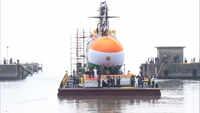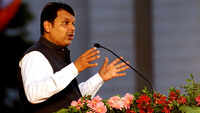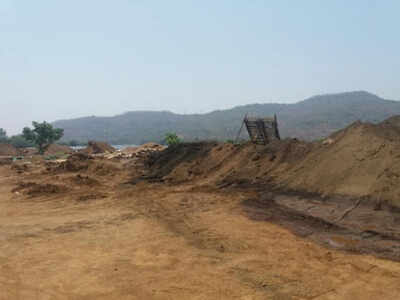
MUMBAI: The anti-sand mining campaign began in 2002 as a Mumbai-centric issue when a sand truck was first intercepted at Kihim beach in Alibaug across the city’s harbour. On Monday, the United Nations, in its first ever report on sand mining, identified India and China as the hotspots for sand extraction impacting rivers, lakes and coastlines.
This is most likely as the two countries lead globally on infrastructure and construction, states the report titled ‘Sand and Sustainability’.
“Two thirds of global cement production occurs in China (58.5%) and India (6.6%). These two countries… look to rapidly transition their populations out of poverty,” reads the report. China produces the most cement globally, at an estimated 2.4 billion tons (2017), followed by India at 270 million tons, and the US at 86.3 million tons.
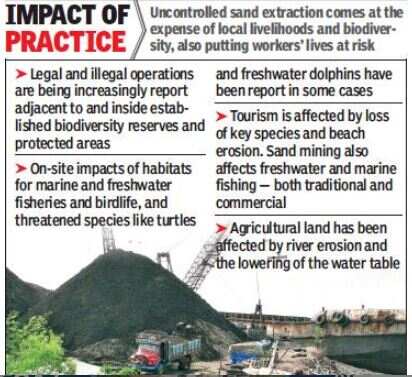
While domestic demand in India is expected to drive strong future growth in Asia, China increased its concrete use by 540% in the last 20 years, exceeding the use of all other countries combined. Even as domestic consumption rates begin to stabilize, China overseas investment in infrastructure development through the Belt and Road Initiative will drive demand for aggregates in approximately 70 countries.
“Though little public data exists about extraction volumes, sources and usages, we know that with some exceptions most sand and gravel extracted from natural environments are consumed regionally because of the high costs of transport,” states the report.
Awaaz Foundation recently launched the 'Save Our Sands' campaign with its focus on alternatives such as recycled plastic, debris, industrial slag and garbage.
This is most likely as the two countries lead globally on infrastructure and construction, states the report titled ‘Sand and Sustainability’.
“Two thirds of global cement production occurs in China (58.5%) and India (6.6%). These two countries… look to rapidly transition their populations out of poverty,” reads the report. China produces the most cement globally, at an estimated 2.4 billion tons (2017), followed by India at 270 million tons, and the US at 86.3 million tons.

While domestic demand in India is expected to drive strong future growth in Asia, China increased its concrete use by 540% in the last 20 years, exceeding the use of all other countries combined. Even as domestic consumption rates begin to stabilize, China overseas investment in infrastructure development through the Belt and Road Initiative will drive demand for aggregates in approximately 70 countries.
“Though little public data exists about extraction volumes, sources and usages, we know that with some exceptions most sand and gravel extracted from natural environments are consumed regionally because of the high costs of transport,” states the report.
Awaaz Foundation recently launched the 'Save Our Sands' campaign with its focus on alternatives such as recycled plastic, debris, industrial slag and garbage.
#ElectionsWithTimes
Elections 2019

Trending Topics
LATEST VIDEOS
City
 Jamshedpur: Woman thrashes man with slipper for posing as anti-corruption officer, demanding Rs 50k
Jamshedpur: Woman thrashes man with slipper for posing as anti-corruption officer, demanding Rs 50k 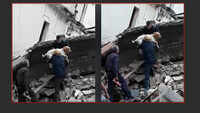 Surat: Pet labrador emerges unhurt from debris miraculously
Surat: Pet labrador emerges unhurt from debris miraculously  On cam: Suspected terrorist tried to enter Bengaluru metro station
On cam: Suspected terrorist tried to enter Bengaluru metro station  Rajasthan cabinet minister Bhanwar Lal Meghwal insults a lady cop on election duty
Rajasthan cabinet minister Bhanwar Lal Meghwal insults a lady cop on election duty
More from TOI
Navbharat Times
Featured Today in Travel
Quick Links
Lok Sabha Election Schedule 2019Lok Sabha Election NewsDelhi Capitals teamMI team 2019Rajasthan Royals 2019RCB team 2019Maharashtra Lok Sabha ConstituenciesBJP Candidate ListBJP List 2019 TamilnaduShiv Sena List 2019AP BJP List 2019Mamata BanerjeeBJP List 2019 MaharashtraPriyanka GandhiBJP List 2019 KarnatakaAMMK Candidate List 2019BJP List 2019 WBLok Sabha Elections in Tamil NaduBSP List 2019 UPNews in TamilLok Sabha Poll 2019Satta Matka 2018PM ModiMahagathbandhanNagpur BJP Candidate ListChandrababu NaiduTamil Nadu ElectionsUrmila MatondkarNews in TeluguMadras High CourtTejashwi YadavArvind KejriwalTejasvi SuryaPawan KalyanArvind KejriwalYogi AdityanathJaya PradaSatta King 2019Srinagar encounter
Get the app

